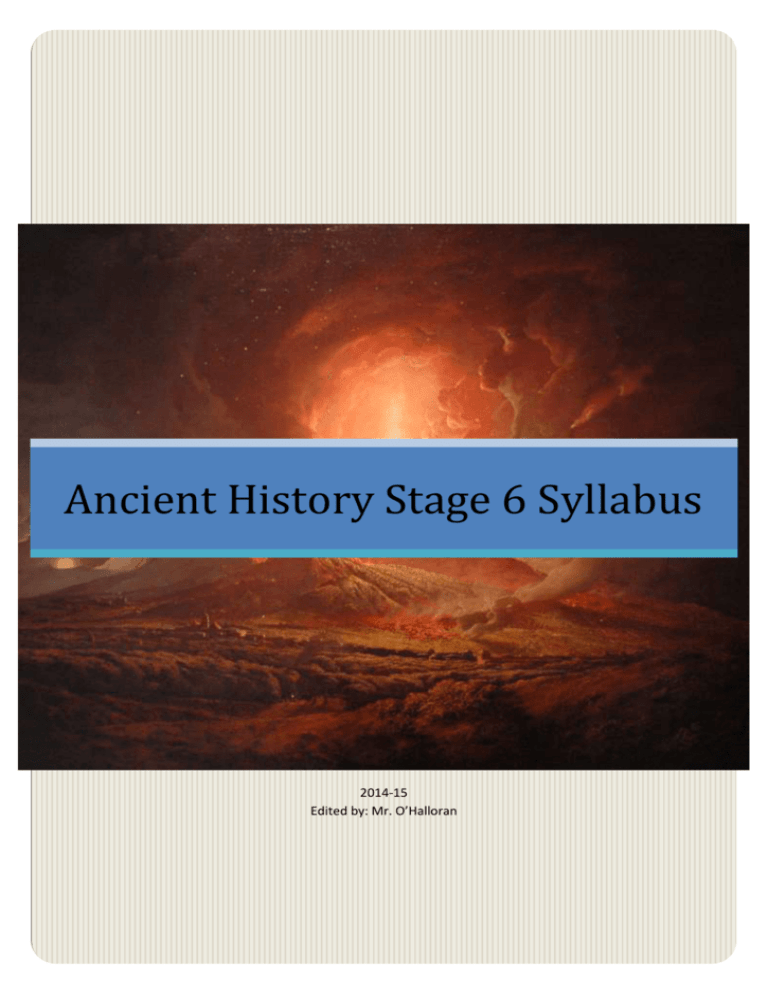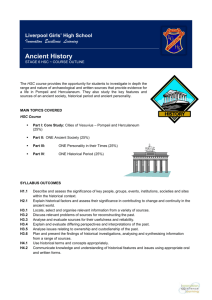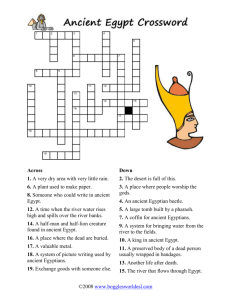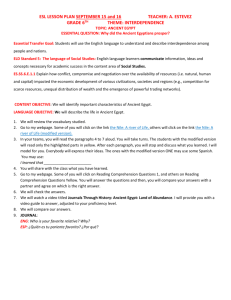Ancient History Stage 6 Syllabus
advertisement

Ancient History Stage 6 Syllabus 2014-15 Edited by: Mr. O’Halloran Ancient History Stage 6 Syllabus Purpose The following document is an edited extract of the Stage 6 Ancient History Syllabus from the Board of Studies. The purpose of this document is for you to create a summary guide which covers all of the content of the Syllabus. The content is found in each topic under the heading “students learn about” in the Syllabus. They are commonly referred to as “dot points”. As we learn the content through the year you will develop sufficient content knowledge to answer short-answer, long-response and extended response questions of sufficient quality to achieve highly in the course. The skills you will require are taken from the “students learn to” section of the syllabus, which, again, is found in each topic of the Syllabus. You will notice that the “students learn to” points sometimes combine the knowledge and details of several dot points. A separate document will be provided for the development of your skills knowledge in Ancient History later in 2014. The template is laid out as follows, and an example of how to fill in the first dot point is provided: Content the physical environment: the geographical setting, natural features and resources of Pompeii and Herculaneum Written Evidence Archaeological Evidence The ancient writer Strabo was one of the first to realise that Vesuvius was a volcano Wine presses and fermentation rooms were found in the ruins of ancient houses in the Vesuvius area. Summary Your summary from class notes goes here Success in Ancient History is not only derived from expert content knowledge, but also in your ability to justify and explain your opinions and knowledge with reference to evidence. There will be an abundance of written and archaeological evidence and you should use this summary document to ensure that you have evidence to back-up your content knowledge 1 Ancient History Stage 6 Syllabus 10.1 Part I: Core Study: Cities of Vesuvius – Pompeii and Herculaneum Percentage of course time: 25% Principal Focus: Students investigate the range and nature of archaeological and written sources available for the study of the cities of Pompeii and Herculaneum through an exploration of issues relating to reconstruction, ownership and custodianship of the past. Outcomes Students: H 1.1 describe and assess the significance of key people, groups, events, institutions, societies and sites within their historical context H 2:1 explain historical factors and assess their significance in contributing to change and continuity in the ancient world H 3.1 locate, select and organise relevant information from a variety of sources H 3.2 discuss relevant problems of sources for reconstructing the past H 3.3 analyse and evaluate sources for their usefulness and reliability H 3.4 explain and evaluate differing perspectives and interpretations of the past H 3.5 analyse issues relating to ownership and custodianship of the past H 3.6 plan and present the findings of historical investigations, analysing and synthesising information from a range of sources H 4.1 use historical terms and concepts appropriately H 4.2 communicate a knowledge and understanding of historical features and issues using appropriate oral and written forms. Students learn to: comprehend and analyse a range of archaeological and written sources relevant to the core study of the cities of Pompeii and Herculaneum use sources to reconstruct aspects of life in Pompeii and Herculaneum in AD 79 evaluate the implications of gaps in the evidence for reconstructing life in Pompeii and Herculaneum in AD 79 describe and assess different methods used by archaeologists, historians and other specialists to investigate the sites over time evaluate different representations of Pompeii and Herculaneum over time discuss relevant issues of conservation and reconstruction; custodianship of the sites and the display of human remains present the findings of investigations of key features or issues relevant to the study of Pompeii and Herculaneum communicate effectively in oral and written forms to describe and analyse features and issues of the study. 2 Ancient History Stage 6 Syllabus Students learn about: Non-examinable background stages of occupation brief historical overview up to and including the eruption of AD 79 early discoveries and brief history of the excavations representations of Pompeii and Herculaneum over time Examinable content: 1 Geographical context the physical environment: the geographical setting, natural features and resources of Pompeii and Herculaneum plans and streetscapes of Pompeii and Herculaneum 2 The nature of sources and evidence the range of available sources, both written and archaeological, including ancient writers, official inscriptions, graffiti, wall paintings, statues, mosaics, human and animal remains the limitations, reliability and evaluation of sources the evidence provided by the sources from Pompeii and Herculaneum for: – the eruption – the economy: trade, commerce, industries, occupations – social structure; men, women, freedmen, slaves – local political life – everyday life: leisure activities, food and dining, clothing, health, baths, water supply and sanitation – public buildings – basilicas, temples, fora, theatres, palaestra, amphitheatres – private buildings – villas, houses, shops – influence of Greek and Egyptian cultures: art, architecture, religion – religion: temples, household gods, foreign cults, tombs. 3 Investigating, reconstructing and preserving the past changing methods and contributions of nineteenth and twentieth century archaeologists to our understanding of Pompeii and Herculaneum changing interpretations: impact of new research and technologies issues of conservation and reconstruction: Italian and international contributions and responsibilities; impact of tourism ethical issues: study and display of human remains 3 Ancient History Stage 6 Syllabus 10.2 Part II: Ancient Societies Principal Focus: The investigation of key features of ONE ancient society through a range of archaeological and written sources and relevant historiographical issues. Percentage of course time: 25% Outcomes Students: H 1.1 describe and assess the significance of key people, groups, events, institutions, societies and sites within their historical context H 2.1 explain historical factors and assess their significance in contributing to change and continuity in the ancient world H 3.1 locate, select and organise relevant information from a variety of sources H 3.2 discuss relevant problems of sources for reconstructing the past H 3.3 analyse and evaluate sources for their usefulness and reliability H 3.4 explain and evaluate differing perspectives and interpretations of the past H 3.6 plan and present the findings of historical investigations, analysing and synthesising information from a range of sources H 4.1 use historical terms and concepts appropriately H 4.2 communicate a knowledge and understanding of historical features and issues using appropriate oral and written forms. ONE ancient society is to be studied from the following: Egypt A Society in Old Kingdom Egypt Dynasties III–VI B Society in New Kingdom Egypt to the death of Amenhotep III C Society in New Kingdom Egypt during the Ramesside period, Dynasties XIX and XX Near East D Assyrian society from Sargon II to Ashurbanipal E Society in Israel from Solomon to the fall of Samaria F Persian society at the time of Darius and Xerxes Greece G The Bronze Age – Minoan Crete H The Bronze Age – Mycenae I Spartan society to the Battle of Leuctra 371 BC J Athenian society in the time of Pericles 4 Ancient History Stage 6 Syllabus Students learn to: ask relevant historical questions locate, select and organise information from a range of sources to describe and analyse the key features of the ancient society describe and evaluate the role and nature of key features of the ancient society explain and assess the significance of historical factors contributing to change and continuity within the ancient society evaluate the usefulness and reliability of sources explain and evaluate differing perspectives and interpretations of the ancient society plan and present the findings of investigations on aspects of the ancient society, analysing and synthesising information from a range of sources communicate an understanding of relevant concepts, features and issues using appropriate oral and written forms. 5 Ancient History Stage 6 Syllabus Option I Greece: Spartan society to the Battle of Leuctra 371 BC Principal Focus: The investigation of key features of Spartan society to the Battle of Leuctra 371 BC, through a range of archaeological and written sources and relevant historiographical issues. Students learn about: 1 The geographical setting – the geographical setting, natural features and resources of ancient Sparta – significant sites: Sparta 2 Social structure and political organisation – the issue of Lycurgus (the Great Rhetra) – roles and privileges of the two kings – government: ephorate, gerousia, ekklesia – social structure: Spartiates, perioeci, ‘inferiors’, helots – role of the Spartan army – control of the helots: the military, syssitia, krypteia – artisans, helots – educational system: agoge – role and status of women: land ownership, inheritance, education 3 The economy – land ownership: agriculture, kleroi, helots – technology: weapons, armour, pottery – economic roles of the periokoi (‘dwellers around’) and helots – economic exchange: use of iron bars, trade 4 Religion, death and burial – gods and goddesses: Artemis Orthia, Poseidon, Apollo – myths and legends: Lycurgus and the Dioscuri – festivals: Hyakinthia, Gymnopaedia, Karneia – religious role of the kings – funerary customs and rituals 5 Cultural life – art: sculpture, painted vases, bone and ivory carving – architecture: Amyklaion, Menelaion, the Sanctuary of Artemis Orthia – writing and literature: Alcman and Tyrtaeus – Greek writers’ views of Sparta: Herodotus, Thucydides, Xenophon, Aristotle, Pausanias, Plutarch 6 Everyday life – daily life and leisure activities – food and clothing – marriage customs – occupations. 6 Ancient History Stage 6 Syllabus 10.3 Part III: Personalities in Their Times Principal Focus: Students gain an understanding of the personality in the context of their time. Percentage of course time: 25% Outcomes Students: H1.1 describe and assess the significance of key people, groups, events, institutions, societies and sites within their historical context H2.1 explain factors and assess their significance in contributing to change and continuity in the ancient world H3.1 locate, select and organise relevant information from a variety of sources H3.2 discuss relevant problems of sources for reconstructing the past H3.3 analyse and evaluate sources for their usefulness and reliability H3.4 explain and evaluate differing perspectives and interpretations of the past H3.6 plan and present the findings of historical investigations, analysing and synthesising information from a range of sources H4.1 use historical terms and concepts appropriately H4.2 communicate a knowledge and understanding of historical features and issues using appropriate oral and written forms ONE personality is to be studied from the following: Egypt A Hatshepsut B Akhenaten C Ramesses II Near East D Sennacherib E Xerxes F Hannibal Greece G Pericles H Alexander the Great I Cleopatra VII Rome J Tiberius Gracchus K Julius Caesar L Agrippina the Younger 7 Ancient History Stage 6 Syllabus Students learn to: use appropriate terms and concepts in communicating about the personality locate, select and organise information in relation to the chosen personality identify key issues and features about the personality make deductions and draw conclusions about the personality weigh up the relative reliability of the available sources and assess their usefulness for a study of the personality identify and analyse the varying images of the personality explain and evaluate differing perspectives and interpretations of the personality in ancient and modern sources present the findings of historical investigations of issues and features of the personality communicate coherently in oral and written forms to explain and evaluate significant events and achievements in the personality’s life synthesise information to construct an evaluation of the personality’s significance and legacy. 8 Ancient History Stage 6 Syllabus Option E The Near East: Xerxes Principal Focus: Students gain an understanding of Xerxes in the context of his time. Students learn about: 1 Historical context – geography, topography and resources of the Persian empire – overview of Persian political, social and military structures – expansion of the Persian empire – overview of religion in the Persian empire – Persian concept of kingship 2 Background and rise to prominence – family background and status – succession to kingship 3 Career – administration of the Persian empire – revolts in the empire: Egypt, Babylon – religious policy – building program: Persepolis – images and representations of Xerxes as king – foreign policy: role in invasion of the Greek mainland – relationship with prominent Persians and non-Persians – manner and impact of his death 4 Evaluation – impact and influence on his time – assessment of his life and reign – legacy – ancient and modern images and interpretations of Xerxes. 9 Ancient History Stage 6 Syllabus 10.4 Part IV: Historical Periods Percentage of course time: 25% Principal Focus: Through an investigation of the archaeological and written sources of ONE historical period, students learn about significant developments and issues that shaped the historical period as well as relevant historiographical issues. Outcomes Students: H 1.1 describe and assess the significance of key people, groups, events, institutions, societies and sites within their historical context H 2.1 explain historical factors and assess their significance in contributing to change and continuity in the ancient world H 3.1 locate, select and organise relevant information from a variety of sources H 3.2 discuss relevant problems of sources for reconstructing the past H 3.3 analyse and evaluate sources for their usefulness and reliability H 3.4 explain and evaluate differing perspectives and interpretations of the past H 3.6 plan and present the findings of historical investigations analysing and synthesising information from a range of sources H 4.1 use historical terms and concepts appropriately H 4.2 communicate a knowledge and understanding of historical features and issues using appropriate oral and written forms. Students learn to: ask relevant historical questions locate, select and organise relevant information form a variety of sources to investigate key developments, forces and issues of the historical period describe and assess significant developments, forces and issues that shaped the historical period explain and assess the significance of historical factors in contributing to change and continuity within the historical period explain the implications of relevant problems of evidence for reconstructing the history of the period analyse and evaluate relevant sources for their usefulness and reliability explain and evaluate differing perspectives and interpretations of the historical period present findings of investigations, analysing and synthesising information from a range of sources communicate a knowledge and understanding of relevant developments and issues that shape the historical period, using appropriate oral and written forms. 10 Ancient History Stage 6 Syllabus ONE historical period is to be studied from the following: Egypt A Egypt: From Unification to the First Intermediate Period B Egypt: New Kingdom Egypt to the death of Thutmose IV C Egypt: New Kingdom Egypt from Amenhotep III to the death of Ramesses II Near East D The Near East: Assyria from Tiglath-Pileser III to the fall of Assyria 609 BC E The Near East: Israel and Judah from Solomon to the fall of Jerusalem F The Near East: Persia from Cyrus II to the death of Darius III Greece G Greece: The development of the Greek world 800 – 500 BC H Greece: The Greek world 500 – 440 BC I Greece: The Greek world 446 – 399 BC J Greece: Fourth-century Greece to the death of Philip II of Macedon Rome K Rome: Rome: 264 – 133 BC L Rome: Political revolution in Rome 133 – 78 BC M Rome: The fall of the Roman Republic 78 – 31 BC N Rome: The Augustan Age 44BC – AD 14 O Rome: Rome in the time of the Julio-Claudians AD 14 – 69 P Rome: The Roman Empire: AD 69 – 235 11 Ancient History Stage 6 Syllabus Option H Greece: The Greek world 500 – 440 BC Principal Focus: Through an investigation of the archaeological and written sources for the Greek world 500 – 440 BC, students learn about significant developments, forces and relevant historiographical issues that shaped the historical period. Students learn about: 1 Persian Wars – origins: Persian imperialism, Ionian Revolt – invasion of 490 BC: Battle of Marathon, role of Miltiades – inter-war period: preparation and developments in Persia and Greece – invasion of 480–479 BC: Battles of Thermopylae and Artemisium, Salamis, Plataea and Mycale – role and contribution of Themistocles, Leonidas, Pausanias, Eurybiades – reasons for Greek victory and Persian defeat 2 Development of Athens and the Athenian Empire – Delian League: origins, aims, organisation and activities to the Battle of the Eurymedon River; role and contribution of Cimon and Aristides the Just – transformation of the Delian League into the Athenian empire – nature of Athenian imperialism; changing relations with allies – key democratic developments: influence of the thetes, ostracism, citizenship law 3 Athens and Sparta – impact of Persian Wars – nature, composition and activities of the Peloponnesian League: Spartan responses to Athenian imperialism 12









